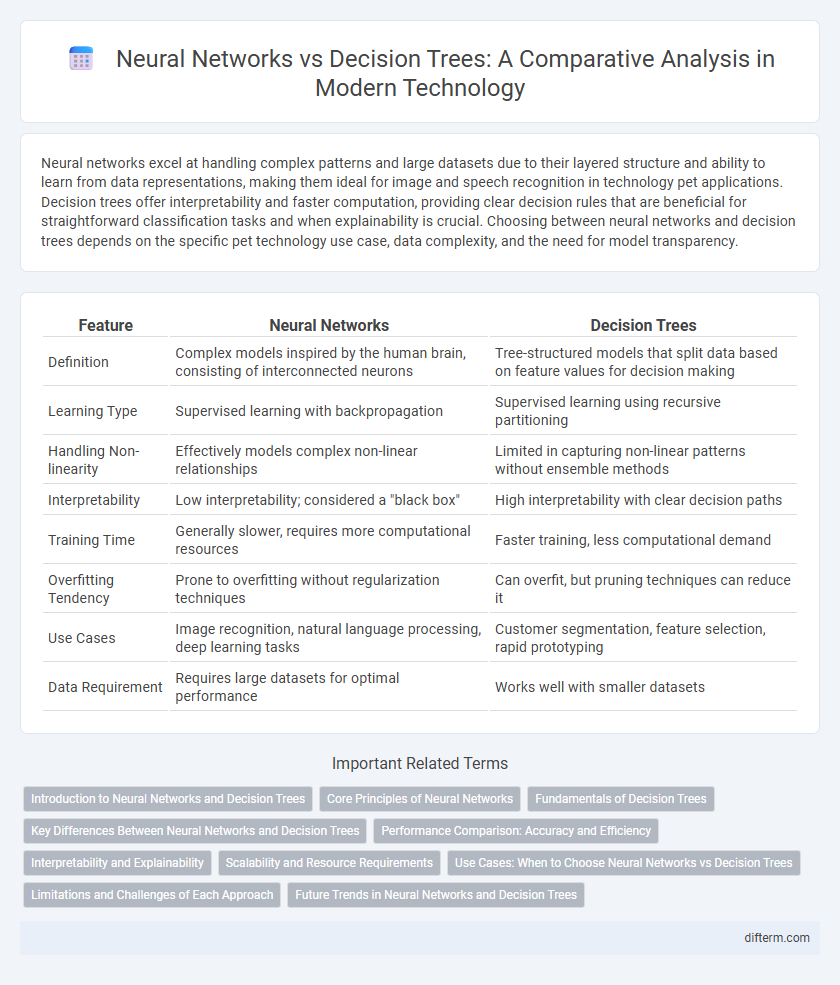Neural networks excel at handling complex patterns and large datasets due to their layered structure and ability to learn from data representations, making them ideal for image and speech recognition in technology pet applications. Decision trees offer interpretability and faster computation, providing clear decision rules that are beneficial for straightforward classification tasks and when explainability is crucial. Choosing between neural networks and decision trees depends on the specific pet technology use case, data complexity, and the need for model transparency.
Table of Comparison
| Feature | Neural Networks | Decision Trees |
|---|---|---|
| Definition | Complex models inspired by the human brain, consisting of interconnected neurons | Tree-structured models that split data based on feature values for decision making |
| Learning Type | Supervised learning with backpropagation | Supervised learning using recursive partitioning |
| Handling Non-linearity | Effectively models complex non-linear relationships | Limited in capturing non-linear patterns without ensemble methods |
| Interpretability | Low interpretability; considered a "black box" | High interpretability with clear decision paths |
| Training Time | Generally slower, requires more computational resources | Faster training, less computational demand |
| Overfitting Tendency | Prone to overfitting without regularization techniques | Can overfit, but pruning techniques can reduce it |
| Use Cases | Image recognition, natural language processing, deep learning tasks | Customer segmentation, feature selection, rapid prototyping |
| Data Requirement | Requires large datasets for optimal performance | Works well with smaller datasets |
Introduction to Neural Networks and Decision Trees
Neural networks are computational models inspired by the human brain's architecture, excelling at pattern recognition and complex data classification through layers of interconnected nodes called neurons. Decision trees operate as hierarchical, rule-based models that split data into branches based on feature values, making them intuitive for classification and regression tasks. Both techniques serve distinct roles in machine learning, with neural networks favoring high-dimensional data and decision trees providing transparent, interpretable outcomes.
Core Principles of Neural Networks
Neural networks operate by mimicking the human brain through interconnected layers of nodes called neurons, each performing weighted calculations on input data to detect complex patterns. The core principle lies in learning representations via backpropagation, adjusting weights to minimize error across layers, enabling deep learning capabilities. Unlike decision trees that rely on hierarchical rule-based splits, neural networks excel in handling unstructured data and capturing non-linear relationships.
Fundamentals of Decision Trees
Decision trees rely on a hierarchical structure where each node represents a feature test, guiding data through branches based on attribute values until reaching a leaf with a decision or classification. This model handles both categorical and numerical data, making it versatile for tasks like regression and classification. The fundamental advantage of decision trees lies in their interpretability and ability to model complex decision boundaries with simple, rule-based logic.
Key Differences Between Neural Networks and Decision Trees
Neural networks excel at handling complex, high-dimensional data through layered architectures that enable deep learning, whereas decision trees provide transparent, rule-based models ideal for straightforward classification and regression tasks. Neural networks require extensive computational resources and longer training times, contrasting with decision trees that train quickly and offer easier interpretability. The adaptability of neural networks suits tasks like image recognition, while decision trees are preferred for problems emphasizing explainability and faster inference.
Performance Comparison: Accuracy and Efficiency
Neural networks typically outperform decision trees in accuracy on complex, high-dimensional datasets due to their ability to model nonlinear relationships and learn hierarchical features. Decision trees offer greater efficiency and interpretability, with faster training times and lower computational costs, making them suitable for real-time applications and smaller datasets. Performance depends on the specific use case, data size, and feature complexity, where neural networks excel in deep learning tasks while decision trees remain competitive in simpler, structured scenarios.
Interpretability and Explainability
Neural networks offer high accuracy but are often criticized for their "black-box" nature, limiting interpretability and explainability in critical applications. Decision trees provide clear, visual decision-making paths that enhance transparency and make it easier for users to understand model reasoning. In fields like healthcare and finance, the interpretability of decision trees is preferred for compliance and trust, despite sometimes lower predictive performance compared to neural networks.
Scalability and Resource Requirements
Neural networks require substantial computational resources and memory, making scalability challenging for large datasets without specialized hardware like GPUs or TPUs. Decision trees offer more efficient scalability with lower resource consumption, easily handling high-dimensional data and large volumes through recursive partitioning. While neural networks excel in capturing complex patterns, decision trees provide faster training and inference times with reduced hardware demands.
Use Cases: When to Choose Neural Networks vs Decision Trees
Neural networks excel in complex pattern recognition tasks such as image and speech recognition, natural language processing, and scenarios involving large, unstructured datasets. Decision trees are more suitable for problems requiring interpretability, fast decision-making, and handling structured data with clear, rule-based relationships, such as credit scoring and medical diagnosis. Choosing between neural networks and decision trees depends on factors like dataset complexity, the need for explainability, and computational resources.
Limitations and Challenges of Each Approach
Neural networks often face challenges such as requiring large amounts of data for training and being prone to overfitting while lacking transparency in decision-making processes, which complicates interpretability. Decision trees can struggle with handling complex patterns and interactions in data, often leading to over-simplified models and sensitivity to noisy or imbalanced datasets. Both methods require careful tuning and domain expertise to mitigate issues related to generalization and computational efficiency.
Future Trends in Neural Networks and Decision Trees
Neural networks are advancing rapidly with developments in deep learning architectures, enabling enhanced pattern recognition and autonomous decision-making across industries. Decision trees are evolving through integration with ensemble methods and explainable AI to improve interpretability and accuracy in complex datasets. Future trends indicate increased hybrid models combining neural networks and decision trees for optimized performance and transparency in AI applications.
Neural networks vs Decision trees Infographic

 difterm.com
difterm.com